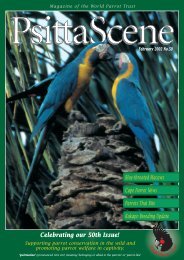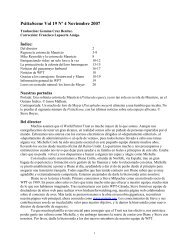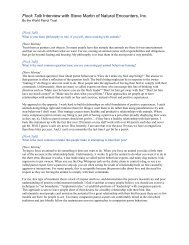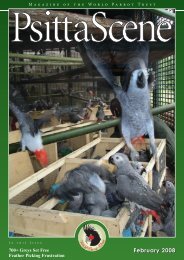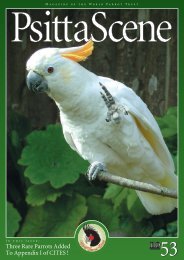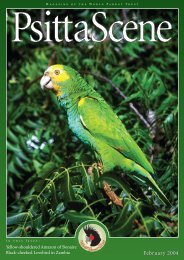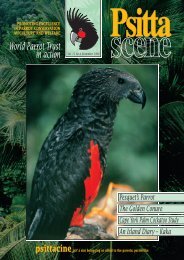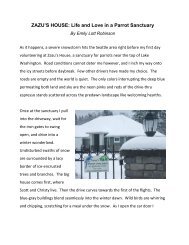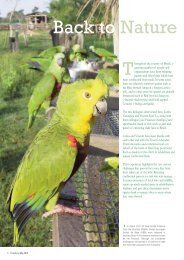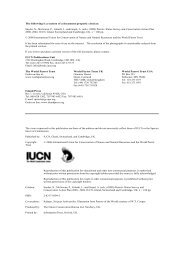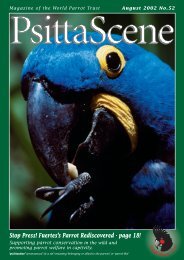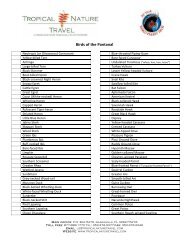Blue-throated Macaw (PDF) - World Parrot Trust
Blue-throated Macaw (PDF) - World Parrot Trust
Blue-throated Macaw (PDF) - World Parrot Trust
Create successful ePaper yourself
Turn your PDF publications into a flip-book with our unique Google optimized e-Paper software.
lue-<strong>throated</strong> macaw<br />
10years<br />
ANSWERING THE QUESTION of “How many<br />
<strong>Blue</strong>-<strong>throated</strong> <strong>Macaw</strong>s are there?” is not<br />
an easy one. Their habitat, the seasonally<br />
flooded savannah in northern Bolivia, is<br />
difficult to access and birds can be spread<br />
out over relatively large areas despite<br />
their limited distribution. Still, attempts<br />
have been made to assess their numbers<br />
based on surveys of known birds. In the<br />
early 80’s information from local people<br />
yielded population estimates ranging from<br />
500 to 1,000 individuals.<br />
However, by the late 1980’s the birds<br />
had all but disappeared. In 1992 Jordan<br />
and Munn discovered a small population<br />
which provided the starting point for<br />
hopes to expand the species range. Since<br />
then, independent surveys have revealed<br />
consistently low numbers of observed<br />
birds and population estimates between<br />
120-200 individuals. While it is difficult<br />
to use limited census data to determine<br />
population size across years and between<br />
different sites, there is sufficient evidence<br />
to show the critically low density of the<br />
<strong>Blue</strong>-<strong>throated</strong> <strong>Macaw</strong>, thus confirming the<br />
Critically Endangered status of this species,<br />
and making it certainly one of the rarest of<br />
all parrots.<br />
© Jamie Gilardi<br />
The <strong>World</strong> <strong>Parrot</strong> <strong>Trust</strong> has had a<br />
team in the field in Bolivia since<br />
2002 - working to preserve the<br />
<strong>Blue</strong>-<strong>throated</strong> <strong>Macaw</strong>, a crically<br />
endangered species. Above,<br />
project leader Igor Berkunsky<br />
checks the health of a nestling.<br />
© Igor Berkunsky<br />
Since 2002, preserving the remaining wild<br />
population of Ara glaucogularis has been the<br />
focus of an intense ongoing <strong>World</strong> <strong>Parrot</strong><br />
<strong>Trust</strong> project. This project has developed<br />
into a complex conservation program,<br />
comprised not only of population surveys<br />
and searches for additional <strong>Blue</strong>-<strong>throated</strong><br />
<strong>Macaw</strong> sites, but also components of habitat<br />
investigation, direct protection of wild nests<br />
and outreach with local and national groups.<br />
August 2012 PsittaScene 3
© Sarah Faegre<br />
© Toa Kyle<br />
© Benoit Gangloff<br />
© Igor Berkunsky<br />
4 PsittaScene August 2012<br />
© Igor Berkunsky<br />
From the top:<br />
Chicks nearly ready for fledging; the<br />
day of fledging from a natural nest;<br />
a plump, healthy chick at 2 months;<br />
success with nest-boxes; installing a<br />
PVC box takes teamwork.<br />
Threats and Actions<br />
Our existing <strong>Blue</strong>-<strong>throated</strong> <strong>Macaw</strong><br />
conservation project focuses on direct<br />
conservation actions aimed at providing<br />
long-term solutions. But first we had to<br />
identify the threats facing the <strong>Blue</strong>-throats<br />
and devise plans to address each of those<br />
limiting factors.<br />
Wild bird trade | Trafficking is a<br />
threat to many parrot species, which are<br />
particularly vulnerable to over-harvesting<br />
due to their low reproductive rates. The<br />
potential of the wild-bird trade to quickly<br />
destroy the last remaining wild population<br />
of <strong>Blue</strong>-<strong>throated</strong> <strong>Macaw</strong>s is a serious issue<br />
warranting immediate attention.<br />
blue-<strong>throated</strong><br />
The intensity of trade in <strong>Blue</strong>-<strong>throated</strong><br />
<strong>Macaw</strong>s during the late 1970s and early<br />
1980s is likely the main factor responsible<br />
for the current low population numbers.<br />
Thankfully, recorded incidents of active<br />
trade during our time in the field have<br />
been minimal, likely due to the species’ low<br />
numbers, its protected status in Bolivia,<br />
and our presence throughout their nesting<br />
territories.<br />
A shortage of cavities | Quality natural<br />
cavities proved to be a very basic limiting<br />
factor identified early for the <strong>Blue</strong>-throats.<br />
Over time we have experimented with<br />
a variety of nest-boxes to determine<br />
what the birds would accept and use<br />
successfully. We have tried an assortment<br />
of materials, orientations, shapes, sizes and<br />
opening dimensions. <strong>Macaw</strong>s curiously<br />
investigated all models and in the end they<br />
laid eggs mostly in wooden, vertical boxes<br />
with large entrance holes. We now have<br />
nest-boxes in all the areas we know <strong>Blue</strong>throats<br />
are breeding.<br />
Since 2007, 4 pairs have used nest-boxes<br />
in eleven different attempts. Not only do<br />
nest-boxes fill a necessary void for the<br />
wild birds, they are also safer than most<br />
natural cavities. Boxes don’t flood, a major<br />
problem with many natural nests, and they<br />
are less prone to predation. Bees are also<br />
less of a problem with artificial boxes,<br />
especially those made of PVC, because<br />
bees tend to abandon the boxes after a few<br />
months. Nest boxes are also easier and<br />
safer for scientists to protect and access,<br />
minimizing disturbance around the nest.<br />
Nest failure | Nests fail for a variety<br />
of reasons. Predation has historically<br />
been our #1 problem. The quest for<br />
solutions is challenging, as it can be<br />
difficult to identify the predators. Antipredator<br />
defenses are now installed at<br />
all nest sites. These can be as simple<br />
as metal flashing wrapped around tree<br />
trunks and branches pruned back from<br />
cavities to abate climbing predators.<br />
Maintaining a high level of daily<br />
monitoring by volunteers is also a great<br />
defense against predation. We have also<br />
installed surveillance and trap cameras<br />
inside nests to identify visitors. We<br />
catch a surprising number of visitors<br />
around nests – the most frequent being<br />
enormous cockroaches, along with frogs<br />
and bats.<br />
In order to help the parents defend their<br />
nests we also sought to reduce the time<br />
they needed to be foraging far away. We<br />
did this by offering bunches of motacú<br />
palm nuts, a favourite natural food, near<br />
some of the active nests. Because of<br />
this, 2010 was the first year in the history<br />
of <strong>Blue</strong>-throat nest monitoring with<br />
zero predated nests.<br />
Flooding | The rains can at times be<br />
relentless – with some seasons being<br />
plagued by days of downpours. In the<br />
past, some cavities have filled with water<br />
at the expense of either chicks or eggs.<br />
Fortunately we have identified all those<br />
nests prone to flooding and created<br />
drainage holes or roofs to protect<br />
the birds from this significant natural<br />
hazard. To our delight, no nests have<br />
flooded since 2008.<br />
Botflies | When botfly eggs hatch on<br />
a macaw, their parasitic larvae burrow<br />
under the skin. They are generally<br />
benign, especially for larger species.<br />
However, we have lost very young chicks<br />
(~5 days) to botflies. We have also had<br />
older chicks (~45 days) infested and in<br />
this case, it is possible for us to remove<br />
the larva without harming the chicks.<br />
Brood reduction | A natural<br />
phenomenon limiting the <strong>Blue</strong>-throat’s<br />
recovery is known as brood reduction.<br />
It is a common result of the normal<br />
hatching asynchrony in parrots. It
happens when those chicks that hatch<br />
first and are larger and stronger,<br />
outcompete the smaller, later-hatching<br />
chicks (see photos pages 4 & 6). While<br />
fledging only one chick might work<br />
for other species, it is not sufficient for<br />
recovery in this case! As a response, we<br />
monitor nests daily, identify any chick(s)<br />
that need a boost, and help them by<br />
hand-feeding. Thanks to our hands-on<br />
management, since 2007, no chicks have<br />
died because of brood reduction and we<br />
have increased the average number of<br />
fledglings per nest from one to two.<br />
(Ara glaucogularis)<br />
© Steve Milpacher<br />
Plans for the Future<br />
The reality is that the <strong>Blue</strong>-<strong>throated</strong><br />
<strong>Macaw</strong> is now a “conservation<br />
dependant species.” That is, we believe<br />
the population cannot recover without<br />
macaw<br />
significant proactive conservation action.<br />
Actions include, but are not limited to,<br />
all the tactics we have employed over<br />
the last decade to increase nest site<br />
availability, protect active nests against<br />
predators, increase nestlings’ survival,<br />
and establish protected areas.<br />
In addition we will focus attention on<br />
some new efforts in the coming years.<br />
a) To ensure long-term genetic variation<br />
of Ara glaucogularis in Bolivia we have<br />
been setting the stage for a captive<br />
breeding and release program. Birds<br />
will be raised at an in-situ breeding and<br />
release center and released on protected<br />
government land with approval of the<br />
Bolivian government.<br />
b) To determine priority release sites<br />
and candidate birds for each site, we will<br />
be analyzing genetic variability in wild<br />
and captive individuals and identifying<br />
potential release sites based on the<br />
quality of available habitat and current<br />
threats.<br />
c) To better understand how this<br />
species is using the habitat we will use<br />
telemetry and satellite tracking. The<br />
Beni savannahs remain flooded for six<br />
months every year, making it impossible<br />
to follow the flocks during the nonbreeding<br />
season. As a result, we have<br />
no information about bird movements.<br />
To know where the birds are during the<br />
rest of the year will help us to propose<br />
protected areas for <strong>Blue</strong>-throats.<br />
d) To increase awareness and advocacy<br />
for the species within Bolivia and<br />
internationally, we will develop and<br />
distribute print and online materials,<br />
articles in popular press, and survey<br />
the materials’ effectiveness.<br />
Through this decade-long sustained<br />
and collective effort, many important<br />
discoveries have been made about<br />
the <strong>Blue</strong>-<strong>throated</strong> <strong>Macaw</strong>’s habitat,<br />
its unique nesting ecology, and the<br />
issues limiting its recovery. Key<br />
factors include the protection and<br />
management of wild nests, the<br />
restoration of select habitat areas<br />
that have been affected by cattle<br />
ranching, and the education of local<br />
stakeholders in determining long-term<br />
land management strategies.<br />
The future of this species will<br />
be determined by the actions we<br />
undertake within the next few years.<br />
Timing is urgent and the need is<br />
great. We appreciate and welcome<br />
your support in helping to save this<br />
critically endangered species.<br />
Contributors: Igor Berkunsky, José A.<br />
Díaz Luque, Federico P. Kacoliris, Gonzalo<br />
Daniele, Steve Milpacher, James D. Gilardi,<br />
& Steve Marn. Edited by Joanna Eckles<br />
Status: Crically Endangered.<br />
Found only in the seasonally<br />
flooded savannahs in northern<br />
Bolivia.<br />
Wild Populaon:<br />
115-120 known individuals<br />
Reproducve Acvity:<br />
10-15 breeding pairs per year<br />
Project Focus: The species was<br />
rediscovered in the wild in 1992.<br />
Since 2002 intensive conservaon<br />
work has been conducted by<br />
<strong>World</strong> <strong>Parrot</strong> <strong>Trust</strong> biologists in<br />
order to idenfy and solve the<br />
crical parameters delaying the<br />
populaon’s recovery.<br />
August 2012 PsittaScene 5
lue-<strong>throated</strong> macaw<br />
stories<br />
“<br />
In late 2005, we were closely watching one of the few successful pairs of <strong>Blue</strong>throats.<br />
They nested in a unique cavity with an unusual gap in the side and<br />
mulple entrances, and their chick was in superb condion, a week or two from<br />
fledging. Normally aer parrots feed their chicks mid-morning, most will fly a<br />
long way off to feed, preen, rest, etc. But on this one day, the adults stuck close<br />
to the nest. It was fascinang to watch them relax and preen one another and<br />
evidently just enjoy each other’s company. At one point, the female leaned into<br />
her mate and rested her head on his shoulder and they both perched moonless.<br />
To complete this capvang scene, the parents could actually see their chick in<br />
the nest … and the chick could see them.<br />
© Jamie Gilardi<br />
“<br />
It wasn’t a normal day. A technician of the<br />
Naonal Natural Resources Agency was<br />
supervising our work in order to approve our<br />
Rescue Center. We decided to visit a site where<br />
we usually have good luck finding macaws. We<br />
approached on foot, walking behind some palm<br />
trees when we heard a group of <strong>Blue</strong>-throats<br />
behind the pens.<br />
The first thing we noced was the voice of<br />
juveniles in the flock. Sure enough, the first<br />
group we spoed was a family of five – the<br />
parents and three juveniles! Through the scope<br />
the birds were so beauful in the sunrise light!<br />
We looked closer and ! all three juveniles<br />
were leg banded, their bands shining in the<br />
sunlight.<br />
We were excited. There can’t be a beer scene<br />
to show, especially for the vising technician’s<br />
first sighng of <strong>Blue</strong>-<strong>throated</strong> <strong>Macaw</strong>s!<br />
We started to scan the tree and found more<br />
birds! To our surprise they were also leg<br />
banded! In a single tree we had seven leg<br />
banded birds plus another adult pair! Then we<br />
We may never know what movates parrots to form these powerful pair bonds<br />
– and to somemes sck with them for decades. And while it’s generally unwise<br />
to project human emoons onto any animal, I was just thrilled to have had this<br />
brief and enchanng peek into the inmate world of a wild parrot family. I came<br />
away thinking that there was something about the adults’ calm sasfacon with<br />
their relaonship, their nest site, and their chick which gave me hope that these<br />
crically threatened birds may yet make it back from the brink of exncon.<br />
-Jamie Gilardi, <strong>World</strong> <strong>Parrot</strong> <strong>Trust</strong> Director<br />
favourites<br />
The 2007-2008 breeding season was the<br />
best on record with the unprecedented<br />
survival of 2 and 3 chicks per nest. Below<br />
is the first family of five wild <strong>Blue</strong>-<strong>throated</strong><br />
<strong>Macaw</strong>s ever recorded (January 2008).<br />
6 PsittaScene August 2012<br />
© Steve Seibel<br />
Photos © Toa Kyle, Sarah Faegre and Igor Berkunsky
heard another call 100 m away and there,<br />
perched in one of the arficial nest boxes,<br />
was another pair.<br />
I can’t imagine a beer situaon that could<br />
summarize all our conservaon efforts with<br />
the <strong>Blue</strong>-<strong>throated</strong> <strong>Macaw</strong>s. All those leg<br />
banded birds we had taken such care of -<br />
some we have fed, some were infected by<br />
bolies which we removed. And those adult<br />
pairs using the nest box… it was so beauful.<br />
-Igor Berkunsky - <strong>Blue</strong>-<strong>throated</strong> <strong>Macaw</strong><br />
Project Leader since 2007<br />
© José A. Díaz Luque © José A. Díaz Luque<br />
“<br />
I remember the first me we flew a <strong>Blue</strong>-<strong>throated</strong> <strong>Macaw</strong> outside! They are magnificent<br />
flyers and wonderful addions to our educaonal shows. They truly eat up the sky as they<br />
soar high over the theater.<br />
They are also the most destrucve of all the parrots in our collecon! They chew anything<br />
and everything. The browse, wooden perches, and toys we provide are modified or<br />
destroyed in minutes! The nest boxes for the breeding birds have to be replaced each year.<br />
But, the most amazing thing to me is how fast a <strong>Blue</strong>-throat can take apart its cage. For the<br />
<strong>Blue</strong>-throats, the special screws holding their cages together are lile more than a mildly<br />
challenging enrichment item. Almost all the pairs in our shows know how to remove the<br />
screws. One pair removed over 20 screws in less than an hour! We now modify their cages<br />
so the screws are all on the outside. Sll, that doesn’t stop them from geng their beaks<br />
through the wire to work on the screws or to unlock a clip and open the door.<br />
<strong>Blue</strong>-throats also have a tendency toward aggression aer a few years. They are difficult<br />
parrots, that’s for sure. But, they are incredibly beauful, intelligent and spectacular in<br />
flight. I so look forward to the day when our birds return to their nave homeland and eat<br />
up the sky over Bolivia. - Steve Marn, Natural Encounters, Inc.<br />
© Steve Milpacher<br />
“<br />
When I joined the <strong>Blue</strong> <strong>throated</strong> macaw project<br />
in 2008, all I had in mind it was an incredible<br />
passion for the parrots. I was really excited to<br />
be involved as a volunteer with the team in<br />
Bolivia.<br />
That first season was hard with unfavorable<br />
condions causing few parrots, including bluethroats,<br />
to breed anywhere in the area. I was so<br />
happy to return in 2009. We all had high hopes<br />
for the new season. Sure enough, things got<br />
excing right away. We found nests as soon as<br />
the season started.<br />
Two out of three eggs hatched from the nest<br />
I was monitoring. At first the parents fed both<br />
chicks but soon, the small chick’s development<br />
began to fall behind. The possibility that the<br />
chick would die was high. Its was a crical<br />
moment – we needed to assist the chick by<br />
feeding it formula. If we didn’t, it would die.<br />
However, if we assist these small chicks during<br />
that crical period, the parents usually start to<br />
feed them again. That’s exactly what happened!<br />
As soon as the lile one could “fight” with his brother when<br />
the parents came with food, it started to grow well. Soon we<br />
started to see both chicks at the cavity entrance looking around.<br />
There was a new world for them outside. It took a long me for<br />
them to be comfortable but finally, four months aer we found<br />
the eggs, both chicks fledged, two days apart.<br />
It’s impossible to describe how I felt when I saw that<br />
small chick that we assisted flying out of the nest. It was<br />
wonderful to experience the whole process from finding a<br />
nest with eggs all the way unl the chicks fledged!<br />
On our last day in the field, we were traveling<br />
on horseback to a cale ranch where the<br />
airplane would pick up us. There I saw the parents<br />
and both chicks fly out the forest. I could<br />
see all four of them, flying free. I’m sure<br />
they were telling us “thank you very<br />
much.” It was definitely one of the<br />
best moments that I have ever had<br />
doing field work!<br />
-José Antonio Díaz<br />
Luque, Field assistant,<br />
<strong>Blue</strong>-<strong>throated</strong> <strong>Macaw</strong> Project<br />
© Gonzalo Daniele<br />
August 2012 PsittaScene 7




